Mobility and Handover Management in 5G/6G Networks: Challenges, Innovations, and Sustainable Solutions
Abstract
1. Introduction
- A focused survey of HO and mobility challenges in 5G UD-HetNets, identifying key problem areas such as FHO, RLF, and signaling overhead;
- A performance-based comparison of state-of-the-art HO techniques and algorithms based on relevant KPIs;
- A discussion on sustainability, AI integration, and adaptive HO strategies for improved network resilience;
- A critical analysis of open research issues and potential directions for future mobility management in B5G/6G networks.
2. Literature Review
2.1. HO in 5G Networks
2.2. Surveys with a Technology-Specific Emphasis
2.3. Mobility-Specific HO
2.4. Advanced Architectures and Optimization-Oriented Studies
2.5. Research Gap
- Lack of critical cross-comparison between strategies using common performance indicators;
- Narrow focus on specific technologies without holistic integration;
- Limited discussion of crucial challenges, like LB, ICI, and HOFR, under high-speed or ultra-dense conditions;
- Absence of comprehensive taxonomies or unified evaluation frameworks.
3. 5G Architecture and Services
3.1. 5G Architecture
3.2. 5G Services
- eMBB delivers high-speed connectivity and increased capacity for data-intensive services such as UHD video streaming, AR/VR, and other multimedia-rich applications. Technologies like massive MIMO, beamforming, and broad frequency bands ensure reliable performance even in high-density environments [39,40].
- mMTC focuses on connecting large volumes of low-power IoT devices, supporting sectors like smart cities, agriculture, and healthcare. It emphasizes coverage, energy efficiency, and the ability to manage massive device densities under constrained conditions [41].
- URLLC is designed for mission-critical applications requiring ultra-low latency (as low as 1 ms) and high reliability, such as autonomous vehicles, remote surgery, and industrial automation. It achieves these goals through network slicing, edge computing, and optimized resource management [42].
3.3. 5G Technologies
3.3.1. 5G and HetNet
3.3.2. mmWave
3.3.3. Massive MIMO
3.3.4. Beamforming
3.3.5. 5G HetNet and FD Communication
3.3.6. D2D Communication
3.3.7. SDN and NFV
4. HO in 5G Networks
- UE continuously measures key parameters such as Reference Signal Received Power (RSRP), Reference Signal Received Quality (RSRQ), and Signal-to-Interference-plus-Noise Ratio (SINR) from both the serving cell (s-gNB) and neighboring cells (T-gNB). These measurements are reported to the serving gNB to assist in the HO decision-making process.
- Based on the measurement reports, network conditions, and predefined policies, the serving gNB determines whether a handover is necessary. Factors such as signal strength, cell load, and UE mobility patterns are considered to select the most suitable target cell (T-gNB).
- The serving gNB initiates communication with the target gNB to prepare for the handover. This involves exchanging necessary information, such as UE context and resource allocation, to ensure a seamless transition. The target gNB reserves resources and configures itself to accommodate the incoming UE.
- Once preparation is complete, the serving gNB sends a HO command to the UE, instructing it to switch to the target gNB. The UE detaches from the serving cell and synchronizes with the target cell, establishing a new connection.
- After successfully connecting to the target gNB, the UE sends a confirmation message to the network. The target gNB notifies the serving gNB of the successful handover, and the serving gNB releases the resources previously allocated to the UE.
- The core network updates the data path to route traffic through the target gNB instead of the serving gNB. This ensures that data transmission continues without interruption.
- Post-handover, the network may perform optimization procedures to fine-tune parameters and ensure optimal performance. This could include adjusting radio resources or re-evaluating handover thresholds based on network conditions.
5. HO Parameters in 5G
5.1. HCPs
5.2. HO Decision Parameters for HO
5.3. KPIs in HO Studies
6. HO Management in 5G Ultra-Dense Small Cell Networks
6.1. Measurement-Based and Experimental Studies
6.2. Optimization Techniques for HO and Mobility Management
- Fuzzy logic controllers: Utilized for their ability to handle uncertainty and imprecision in network parameters such as signal strength, user velocity, and load, enabling dynamic adaptation of handover thresholds and timers.
- Metaheuristic algorithms: Techniques like Bayesian Optimization, Ant Lion Optimization, and hybrid methods (e.g., combining Kinetic Gas Molecular Optimization with other algorithms) are leveraged to solve multi-objective optimization problems, balancing trade-offs like reducing handover rates while maintaining QoS.
- Bayesian and machine learning-based optimization: These approaches enable the proactive tuning of handover parameters by learning from network state and user behavior, improving decision accuracy with fewer trial-and-error cycles.
6.3. AI/ML-Based Approaches
- Sequence-to-sequence and time series prediction: These are used to forecast handover cells, dwell times, and user trajectories, helping to anticipate network resource requirements and optimize handover timing;
- Reinforcement learning and deep learning: These are applied to learn optimal handover policies in dynamic network environments, balancing trade-offs like handover frequency, latency, and throughput;
- Hybrid and ensemble models: Combining multiple ML algorithms to improve prediction accuracy and robustness in varying mobility scenarios.
6.4. SDN/NFV and Network Slicing-Based Solutions
6.5. Vehicular and High-Speed Mobility Management
6.6. Mobility Management in mmWave, THz, and Ultra-Dense Networks
6.7. HO Algorithms for D2D, MIAB, and Integrated Systems
6.8. Mobility Prediction Techniques in 5G Networks
6.9. Emerging Mobility Mechanisms in 5G-Advanced: Layer 1/Layer 2 Triggered Mobility (LTM)
7. Research Challenges
7.1. Network Complexity and Scalability
7.2. Energy Efficiency and Sustainability
7.3. Spectrum Management and Interference
7.4. Security and Privacy
7.5. Latency and Mobility Management
7.6. Future Challenges in 6G Mobility
7.7. Emerging Architectures: Non-Terrestrial and Digital Twin Networks
8. Performance Analysis
9. Conclusions
Author Contributions
Funding
Conflicts of Interest
Abbreviations
| UE | user equipment |
| 3GPP | 3rd generation partnership project |
| ITU | International Telecommunication Union |
| IoT | Internet of things |
| D2D | device-to-device |
| V2V | vehicle-to-vehicle |
| EC | edge computing |
| MEC | mobile edge computing |
| HetNet | heterogeneous network |
| UD-HetNet | ultra-dense heterogeneous network |
| mmWave | millimeter wave |
| MIMOs | multiple-input-multiple-outputs |
| B5G | beyond-5G |
| QoS | quality of service |
| QoE | quality of experience |
| HO | handover |
| RSS | received signal strength |
| MBS | macro base station |
| SBS | small base station |
| BS | base station |
| RLF | radio link failure |
| CCI | co-channel interference |
| KPIs | key performance indicators |
| LTE-A | LTE-advanced |
| 5G-NR | 5G New Radio |
| CoMPs | coordinated multiple points |
| eNB | Node B |
| ICIC | inter-cell interference coordination |
| CN | core network |
| EPC | evolved packet core |
| RAN | radio access network |
| NR | new radio |
| SDN | software-defined networking |
| ML | machine learning |
| LB | load balancing |
| LTE | long-term evolution |
| UAVs | unmanned aerial vehicles |
| IoE | internet of everything |
| SA | standalone |
| NSA | non-standalone |
| eMBB | enhanced mobile broadband |
| mMTCs | massive machine-type communications |
| URLLCs | ultra-reliable low-latency communications |
| M2M | machine-to-machine |
| FD | full-duplex |
| RATs | radio access technologies |
| ICI | inter-cell interference |
| SINR | signal-to-interference-plus-noise ratio |
| SNR | extremely-high frequency |
| SNR | signal-to-noise ratio |
| NFV | network function virtualization |
| H-HO | hard HO |
| S-HO | soft HO |
| HHO | horizontal handover |
| VHO | vertical Handover |
| HOIT | handover interruption time |
| MR | measurement report |
| HODPs | handover decision parameters |
| HCPs | handover control parameters |
| TTT | time-to-trigger |
| RSRP | reference signal received power |
| RSRQ | reference signal received quality |
| RSSI | RSS indicator |
| CSI | channel state information |
| HOM | HO margin |
| CIO | cell individual offset |
| MRO | mobility robustness optimization |
| LBO | load-balancing optimization |
| HOPPs | handover probability problems |
| HPPP | handover ping-pong probability |
| HOR | HO rate |
| HOFR | HO failure rate |
| HOSR | HO success rate |
| HOD | HO delay |
| HOET | HO execution time |
| HPSO | handover parameter self-optimization |
| CDF | cumulative distribution function |
| NTNs | non-terrestrial networks |
| LEO | low Earth orbit |
| HAPs | high-altitude platforms |
| DTNs | digital twin networks |
References
- Pompigna, A.; Mauro, R. Smart roads: A state of the art of highways innovations in the Smart Age. Eng. Sci. Technol. Int. J. 2022, 25, 100986. [Google Scholar] [CrossRef]
- Ullah, Y.; Roslee, M.B.; Mitani, S.M.; Khan, S.A.; Jusoh, M.H. A survey on handover and mobility management in 5G HetNets: Current state, challenges, and future directions. Sensors 2023, 23, 5081. [Google Scholar] [CrossRef] [PubMed]
- Saad, S.A.; Shayea, I.; Ahmed, N.M.S. Artificial intelligence linear regression model for mobility robustness optimization algorithm in 5G cellular networks. Alex. Eng. J. 2024, 89, 125–148. [Google Scholar] [CrossRef]
- Dao, N.N.; Tu, N.H.; Hoang, T.D.; Nguyen, T.H.; Nguyen, L.V.; Lee, K.; Park, L.; Na, W.; Cho, S. A review on new technologies in 3GPP standards for 5G access and beyond. Comput. Netw. 2024, 245, 110370. [Google Scholar] [CrossRef]
- Pedersen, K.; Maldonado, R.; Pocovi, G.; Juan, E.; Lauridsen, M.; Kovács, I.Z.; Brix, M.; Wigard, J. A Tutorial on Radio System-Level Simulations With Emphasis on 3GPP 5G-Advanced and Beyond. IEEE Commun. Surv. Tutor. 2024, 26, 2290–2325. [Google Scholar] [CrossRef]
- Zhou, H.; Zhou, H.; Li, J.; Yang, K.; An, J.; Shen, X. Heterogeneous ultra-dense networks with traffic hotspots: A unified handover analysis. IEEE Internet Things J. 2023, 10, 8825–8838. [Google Scholar] [CrossRef]
- Khan, A.; Ahmad, S.; Ali, I.; Hayat, B.; Tian, Y.; Liu, W. Dynamic mobility and handover management in software-defined networking-based fifth-generation heterogeneous networks. Int. J. Netw. Manag. 2024, 35, e2268. [Google Scholar] [CrossRef]
- Ashraf, S.; Sheikh, J.A.; Ashraf, A.; Rasool, U. 5G Millimeter Wave Technology: An Overview. In Intelligent Signal Processing and RF Energy Harvesting for State of art 5G and B5G Networks; Springer: Singapore, 2024; pp. 97–112. [Google Scholar]
- Xia, X.; Yu, C.; Wu, F.; Jiang, Z.H.; Li, Y.L.; Yao, Y.; Hong, W. Millimeter-wave phased array antenna integrated with the industry design in 5G/B5G smartphones. IEEE Trans. Antennas Propag. 2023, 71, 1883–1888. [Google Scholar] [CrossRef]
- Salah, I.; Rahouma, K.H.; Hussein, A.I.; Mabrook, M.M. Throughput, Spectral, and Energy Efficiency of 5G Massive MIMO Applications Using Different Linear Precoding Schemes. Int. J. Electron. Telecommun. 2023, 69, 185–191. [Google Scholar] [CrossRef]
- Singh, D. Performance of Kalman-Based Precoding in Millimeter-Wave Communication. In Proceedings of the Proceedings of First International Conference on Computational Electronics for Wireless Communications: ICCWC 2021, Haryana, India, 11–12 June 2021; Springer: Singapore, 2022; pp. 645–653. [Google Scholar]
- Scanzio, S.; Wisniewski, L.; Gaj, P. Heterogeneous and dependable networks in industry—A survey. Comput. Ind. 2021, 125, 103388. [Google Scholar] [CrossRef]
- Saxena, S.; Chandan, R.R.; Krishnamoorthy, R.; Kumar, U.; Singh, P.; Pandey, A.K.; Gupta, S.K. Original Research Article Transforming transportation: Embracing the potential of 5G, heterogeneous networks, and software defined networking in intelligent transportation systems. J. Auton. Intell. 2024, 7, 1–14. [Google Scholar]
- Chen, J.B.; Chu, Q.X. Mixed Metal Decoupling Structure for 5G MIMO Base Station Antenna Array. In Proceedings of the 2023 16th UK-Europe-China Workshop on Millimetre Waves and Terahertz Technologies (UCMMT), Guangzhou, China, 31 August–3 September 2023; IEEE: Piscataway, NJ, USA, 2023; Volume 1, pp. 1–3. [Google Scholar]
- Mohd Asri, L.; Wan Ariffin, W.; Md Zain, A.; Saad, N. Performance analysis of coordinated multi-point (CoMP) with energy trading and management in green cloud RAN. AIP Conf. Proc. 2024, 2898, 030005. [Google Scholar]
- Yuksekkaya, B.; Demir, U.; Bulu, G. Interference aware two-tier fair user-cell association. AEU Int. J. Electron. Commun. 2024, 177, 155194. [Google Scholar] [CrossRef]
- Nayak, R.; Pavanalaxmi, S.; Kumar, P. 5G-6G: Infrastructure and Industrial Applications. In Innovations in Engineering and Food Science; IGI Global: New York, NY, USA, 2024; pp. 1–22. [Google Scholar]
- Benson, M.E.; Okafor, K.C.; Ezema, L.S.; Chukwuchekwa, N.; Adebisi, B.; Anthony, O.C. Heterogeneous cyber-physical network coexistence through interference contribution rate and uplink power control algorithm (ICR-UPCA) in 6G edge cells. Internet Things 2024, 25, 101031. [Google Scholar] [CrossRef]
- Abdel-Halim, A.M.; El-Desouky, M.A. Tackling RF Interference Challenges: A Survey of ICIC Schemes for OFDM Downlink in Cellular Networks. Hollex Int. J. Sci. Eng. Technol. 2024, 12, 1–16. [Google Scholar]
- Salahdine, F.; Han, T.; Zhang, N. 5G, 6G, and Beyond: Recent advances and future challenges. Ann. Telecommun. 2023, 78, 525–549. [Google Scholar] [CrossRef]
- Khan, S.A.; Shayea, I.; Ergen, M.; Mohamad, H. Handover management over dual connectivity in 5G technology with future ultra-dense mobile heterogeneous networks: A review. Eng. Sci. Technol. Int. J. 2022, 35, 101172. [Google Scholar] [CrossRef]
- Banafaa, M.; Pepeoğlu, Ö.; Shayea, I.; Alhammadi, A.; Shamsan, Z.; Razaz, M.A.; Alsagabi, M.; Al-Sowayan, S. A comprehensive survey on 5G-and-beyond networks with UAVs: Applications, emerging technologies, regulatory aspects, research trends and challenges. IEEE Access 2024, 12, 7786–7826. [Google Scholar] [CrossRef]
- Odida, M. The Evolution of Mobile Communication: A Comprehensive Survey on 5G Technology. J. Sens. Netw. Data Commun. 2024, 4, 1–11. [Google Scholar]
- Ishteyaq, I.; Muzaffar, K.; Shafi, N.; Alathbah, M.A. Unleashing the Power of Tomorrow: Exploration of Next Frontier with 6G Networks and Cutting Edge Technologies. IEEE Access 2024, 12, 29445–29463. [Google Scholar] [CrossRef]
- Tanveer, J.; Haider, A.; Ali, R.; Kim, A. An overview of reinforcement learning algorithms for handover management in 5G ultra-dense small cell networks. Appl. Sci. 2022, 12, 426. [Google Scholar] [CrossRef]
- Dhara, S.; Das, S.; Shrivastav, A.K. Performance evaluation and downstream system planning based energy management in LTE systems. Multimed. Tools Appl. 2024, 83, 1787–1840. [Google Scholar] [CrossRef]
- Mangipudi, P.K.; McNair, J. Sdn enabled mobility management in multi radio access technology 5g networks: A survey. arXiv 2023, arXiv:2304.03346. [Google Scholar]
- Fathy, A.; Osama, A.; Reda, G.; Ali, N.A. Performance Evaluation of Scheduling Algorithms of LTE and LTE-A Mobile Networks using Vienna Simulator. Fayoum Univ. J. Eng. 2024, 7, 53–60. [Google Scholar] [CrossRef]
- Kumbhar, A. Performance Improvement Using ICIC for UAV-Assisted Public Safety Networks with Clustered Users during Emergency. Telecom 2023, 4, 816–835. [Google Scholar] [CrossRef]
- Khan, S.A.; Chowdhury, M.M.H.; Nandy, U. LTE/LTE-A Based Advanced Wireless Networks. J. Eng. Res. Rep. 2023, 25, 195–199. [Google Scholar] [CrossRef]
- Umarovich, I.U.; Fazlitdinovna, J.G. Comarison Approach to the Several Protocols of Radio Interfaces of LTE Technology. Int. J. Adv. Sci. Res. 2023, 3, 117–124. [Google Scholar]
- Vilakazi, M.; Olwal, T.O.; Mfupe, L.P.; Lysko, A. OpenAir Interface for 4G Core Network and 4G/5G Base Stations. In Proceedings of the 2023 International Conference on Electrical, Computer and Energy Technologies (ICECET), Cape Town, South Africa, 16–17 November 2023; IEEE: Piscataway, NJ, USA, 2023; pp. 1–7. [Google Scholar]
- Saha, R.K.; Cioffi, J.M. Dynamic Spectrum Sharing for 5G NR and 4G LTE Coexistence-A Comprehensive Review. IEEE Open J. Commun. Soc. 2024, 5, 795–835. [Google Scholar] [CrossRef]
- 5G PPP Architecture Working Group. View on 5G Architecture: Version 2.0; 5G PPP Association: Brussels, Belgium, 2017. [Google Scholar]
- Townend, D.; Husbands, R.; Walker, S.D.; Sutton, A. Challenges and Opportunities in Wireless Fronthaul. IEEE Access 2023, 11, 106607–106619. [Google Scholar] [CrossRef]
- Yang, J.; Wen, C.K.; Xu, J.; Que, H.; Wei, H.; Jin, S. Angle-based SLAM on 5G mmWave systems: Design, implementation, and measurement. IEEE Internet Things J. 2023, 10, 17755–17771. [Google Scholar] [CrossRef]
- Jaffry, S.; Hussain, R.; Gui, X.; Hasan, S.F. A comprehensive survey on moving networks. IEEE Commun. Surv. Tutor. 2020, 23, 110–136. [Google Scholar] [CrossRef]
- Yu, H.; Lee, H.; Jeon, H. What is 5G? Emerging 5G mobile services and network requirements. Sustainability 2017, 9, 1848. [Google Scholar] [CrossRef]
- Navarro-Ortiz, J.; Romero-Diaz, P.; Sendra, S.; Ameigeiras, P.; Ramos-Munoz, J.J.; Lopez-Soler, J.M. A survey on 5G usage scenarios and traffic models. IEEE Commun. Surv. Tutor. 2020, 22, 905–929. [Google Scholar] [CrossRef]
- Eiji, A.; Mehta, S. Simulation-Based 5G Femtocell Network System Performance Analysis. Int. J. Cyber IT Serv. Manag. 2023, 3, 74–78. [Google Scholar] [CrossRef]
- Mohammadkarimi, M.; Ardakani, M. Efficient Massive Machine Type Communication (mMTC) via AMP. IEEE Wirel. Commun. Lett. 2023, 12, 1002–1006. [Google Scholar] [CrossRef]
- Sefati, S.S.; Halunga, S. Ultra-reliability and low-latency communications on the internet of things based on 5G network: Literature review, classification, and future research view. Trans. Emerg. Telecommun. Technol. 2023, 34, e4770. [Google Scholar] [CrossRef]
- Pons, M.; Valenzuela, E.; Rodríguez, B.; Nolazco-Flores, J.A.; Del-Valle-Soto, C. Utilization of 5G technologies in IoT applications: Current limitations by interference and network optimization difficulties—A review. Sensors 2023, 23, 3876. [Google Scholar] [CrossRef]
- Alam, M.J.; Hossain, M.R.; Azad, S.; Chugh, R. An overview of LTE/LTE-A heterogeneous networks for 5G and beyond. Trans. Emerg. Telecommun. Technol. 2023, 34, e4806. [Google Scholar] [CrossRef]
- Sathya, V.; Kala, S.M.; Naidu, K. Heterogenous networks: From small cells to 5G NR-U. Wirel. Pers. Commun. 2023, 128, 2779–2810. [Google Scholar] [CrossRef]
- Zafar, S.; Jangsher, S.; Zafar, A. Federated learning for resource allocation in vehicular edge computing-enabled moving small cell networks. Veh. Commun. 2024, 45, 100695. [Google Scholar] [CrossRef]
- Sáez-de Cámara, X.; Flores, J.L.; Arellano, C.; Urbieta, A.; Zurutuza, U. Clustered federated learning architecture for network anomaly detection in large scale heterogeneous IoT networks. Comput. Secur. 2023, 131, 103299. [Google Scholar] [CrossRef]
- Chowdhury, D.R.; Nandi, S.; Goswami, D. Cost-effective live video streaming for internet of connected vehicles using heterogeneous networks. Ad Hoc Netw. 2024, 153, 103334. [Google Scholar] [CrossRef]
- Sufyan, A.; Khan, K.B.; Khashan, O.A.; Mir, T.; Mir, U. From 5G to beyond 5G: A comprehensive survey of Wireless network evolution, challenges, and promising technologies. Electronics 2023, 12, 2200. [Google Scholar] [CrossRef]
- Gheyas, I.; Raschella, A.; Mackay, M. Optimal Meshing Degree Performance Analysis in a mmWave FWA 5G Network Deployment. Future Internet 2023, 15, 218. [Google Scholar] [CrossRef]
- Alaaedi, H.; Sabaei, M. Millimeter Wave Massive MIMO Heterogeneous Networks Using Fuzzy-Based Deep Convolutional Neural Network (FDCNN). Intell. Autom. Soft Comput. 2023, 36, 636–646. [Google Scholar] [CrossRef]
- Abdelrahim, E.M.; Alduailij, M.; Alduailij, M.; Mansour, R.F.; Ghoneim, O.A. An Optimized Approach for Spectrum Utilization in mmWave Massive MIMO 5G Wireless Networks. Comput. Syst. Sci. Eng. 2023, 47, 1493–1505. [Google Scholar] [CrossRef]
- Marwaha, S.; Jorswieck, E.A.; Jassim, M.; Kürner, T.; Pérez, D.L.; Geng, X.; Bao, H. Energy Efficient Operation of Adaptive Massive MIMO 5G HetNets. IEEE Trans. Wirel. Commun. 2023, 23, 6889–6904. [Google Scholar] [CrossRef]
- Li, H.; Cao, J.; Luo, G.; Wang, Z.; Wang, H. A Novel Performance Bound for Massive MIMO Enabled HetNets. Mathematics 2023, 11, 2846. [Google Scholar] [CrossRef]
- Zhang, Z.; Jiang, Z.; Yang, B.; She, X. A Beamforming-Based Enhanced Handover Scheme with Adaptive Threshold for 5G Heterogeneous Networks. Electronics 2023, 12, 4131. [Google Scholar] [CrossRef]
- Hefnawi, M.; Zbitou, J. MIMO Hybrid Beamforming: Performance Assessment in Macrocells and HetNets. In Handbook of Research on Emerging Designs and Applications for Microwave and Millimeter Wave Circuits; IGI Global: New York, NY, USA, 2023; pp. 1–28. [Google Scholar]
- Singh, A.K.; Sahana, B.C. Full Duplex-Non-Orthogonal Multiple Access for V2X Communications in 5G Millimeter Wave. Wirel. Pers. Commun. 2024, 136, 1825–1848. [Google Scholar] [CrossRef]
- Cruickshank, D.B. Implementing Full Duplexing for 5G; Artech House: Norwood, MA, USA, 2020. [Google Scholar]
- Adnan, M.H.; Ahmad Zukarnain, Z. Device-to-device communication in 5G environment: Issues, solutions, and challenges. Symmetry 2020, 12, 1762. [Google Scholar] [CrossRef]
- Mishra, A.; Swain, A.; Ray, A.K.; Shubair, R.M. HetNet/M2M/D2D communication in 5G technologies. In 5G IoT and Edge Computing for Smart Healthcare; Elsevier: Amsterdam, The Netherlands, 2022; pp. 45–87. [Google Scholar]
- Condoluci, M.; Mahmoodi, T.; Araniti, G. Software-defined networking and network function virtualization for C-RAN systems. In 5G Radio Access Networks; CRC Press: Boca Raton, FL, USA, 2017; pp. 117–133. [Google Scholar]
- Fan, C.; Cui, J.; Zhong, H.; Bolodurina, I.; He, D. MM-SDVN: Efficient Mobility Management Scheme for Optimal Network Handover in Software Defined Vehicular Network. IEEE Internet Things J. 2024, 11, 32089–32104. [Google Scholar] [CrossRef]
- Alam, M.J.; Chugh, R.; Azad, S.; Hossain, M.R. Ant colony optimization-based solution to optimize load balancing and throughput for 5G and beyond heterogeneous networks. EURASIP J. Wirel. Commun. Netw. 2024, 2024, 44. [Google Scholar] [CrossRef]
- Yuhanef, A.; Chandra, D.; Yuhanef, A.; Akhyar, A.H.M. Handover Analysis Of 4G LTE (Long Term Evolution) At A Frequency Of 2400 Mhz. Inspir. J. Teknol. Inf. Dan Komun. 2023, 13, 14–24. [Google Scholar]
- Thillaigovindhan, S.K.; Roslee, M.; Mitani, S.M.I.; Osman, A.F.; Ali, F.Z. A Comprehensive Survey on Machine Learning Methods for Handover Optimization in 5G Networks. Electronics 2024, 13, 3223. [Google Scholar] [CrossRef]
- Hassan, A.; Narayanan, A.; Zhang, A.; Ye, W.; Zhu, R.; Jin, S.; Carpenter, J.; Mao, Z.M.; Qian, F.; Zhang, Z.L. Vivisecting mobility management in 5G cellular networks. In Proceedings of the ACM SIGCOMM 2022 Conference, Amsterdam, The Netherlands, 22–26 August 2022; pp. 86–100. [Google Scholar]
- Jon, J.H.; Jong, C.; Ryu, K.S.; Kim, W. Enhanced uplink handover scheme for improvement of energy efficiency and QoS in LTE-A/5G HetNet with ultra-dense small cells. Wirel. Netw. 2024, 30, 1321–1338. [Google Scholar] [CrossRef]
- Maiwada, U.D.; Danyaro, K.U.; Sarlan, A.B.; Aliyu, A.A. Dynamic Handover Optimization Protocol to enhance energy efficiency within the A-LTE 5G network’s two-tier architecture. Int. J. Data Inform. Intell. Comput. 2024, 3, 8–15. [Google Scholar]
- Alraih, S.; Nordin, R.; Abu-Samah, A.; Shayea, I.; Abdullah, N.F.; Alhammadi, A. Robust handover optimization technique with fuzzy logic controller for beyond 5G mobile networks. Sensors 2022, 22, 6199. [Google Scholar] [CrossRef]
- de Carvalho Rodrigues, E.; Rial, A.V.; Geraci, G. Towards mobility management with multi-objective Bayesian optimization. In Proceedings of the 2023 IEEE Wireless Communications and Networking Conference (WCNC), Glasgow, UK, 26–29 March 2023; IEEE: Piscataway, NY, USA, 2023; pp. 1–6. [Google Scholar]
- Tashan, W.; Shayea, I.; Aldirmaz-Colak, S.; El-Saleh, A.A. Voronoi-based handover self-optimization technique for handover ping-pong reduction in 5G networks. In Proceedings of the 2023 10th International Conference on Wireless Networks and Mobile Communications (WINCOM), Istanbul, Turkiye, 26–28 October 2023; IEEE: Piscataway, NY, USA, 2023; pp. 1–6. [Google Scholar]
- Sarala, L.; Mahalakshmi, T.; Kandarkar, S.M.; Sriramam, Y.S.; Arun, M.; Varma, K.S. Virtualization Framework for Securing Cloud to 5G Networks Using Ant Lion Optimization Constructed KGMO for Mobility Supervision. In Proceedings of the 2023 International Conference on Sustainable Emerging Innovations in Engineering and Technology (ICSEIET), Ghaziabad, India, 14–15 September 2023; IEEE: Piscataway, NY, USA, 2023; pp. 725–731. [Google Scholar]
- Venkata Narasimha Reddy, G.; Jayudu, T.V.N.; Komarolu, J.; Rajesh, N.; Reddy, B.L.N. Ant lion optimization based inertia weight optimized KGMO for mobility Management in Heterogeneous LTE cellular networks. Multimed. Tools Appl. 2024, 84, 17907–17928. [Google Scholar] [CrossRef]
- Tashan, W.; Shayea, I.; Sheikh, M.; Arslan, H.; El-Saleh, A.A.; Saad, S.A. Adaptive handover control parameters over voronoi-based 5G networks. Eng. Sci. Technol. Int. J. 2024, 54, 101722. [Google Scholar] [CrossRef]
- Riaz, H.; Öztürk, S.; Çalhan, A. A Robust Handover Optimization Based on Velocity-Aware Fuzzy Logic in 5G Ultra-Dense Small Cell HetNets. Electronics 2024, 13, 3349. [Google Scholar] [CrossRef]
- Yajnanarayana, V. Proactive mobility management of ues using sequence-to-sequence modeling. In Proceedings of the 2022 National Conference on Communications (NCC), Mumbai, India, 24–27 May 2022; IEEE: Piscataway, NY, USA, 2022; pp. 320–325. [Google Scholar]
- Zaidi, S.M.A.; Farooq, H.; Rizwan, A.; Abu-Dayya, A.; Imran, A. A framework to address mobility management challenges in emerging networks. IEEE Wirel. Commun. 2023, 30, 90–97. [Google Scholar] [CrossRef]
- Makai, L.B.; Varga, P. Predicting Mobility Management Demands of Cellular Networks based on User Behavior. In Proceedings of the NOMS 2023-2023 IEEE/IFIP Network Operations and Management Symposium, Miami, FL, USA, 8–12 May 2023; IEEE: Piscataway, NY, USA, 2023; pp. 1–6. [Google Scholar]
- Pjanić, D.; Sopasakis, A.; Reial, A.; Tufvesson, F. Early-Scheduled Handover Preparation in 5G NR Millimeter-Wave Systems. IEEE Open J. Commun. Soc. 2024, 5, 6959–6971. [Google Scholar] [CrossRef]
- Arwa, A.; Hend, K.; Faouzi, Z. Handover Management in a Sliced 5G Network Using Deep Reinforcement Learning. In Proceedings of the 2024 International Wireless Communications and Mobile Computing (IWCMC), Ayia Napa, Cyprus, 27–31 May 2024; IEEE: Piscataway, NY, USA, 2024; pp. 1394–1399. [Google Scholar]
- Aljbour, S.H.; Alma’aitah, A.Y. An inter/intra slice handover scheme for mobility management in 5G network. In Proceedings of the 2022 13th International Conference on Information and Communication Systems (ICICS), Irbid, Jordan, 21–23 June 2022; IEEE: Piscataway, NY, USA, 2022; pp. 87–92. [Google Scholar]
- Sinha, A.; Uduthalapally, V.; Das, D.; Mahapatra, R. SDN-Based Seamless Mobility Management for B5G Services in High-Speed Railways. In Proceedings of the 2023 IEEE International Conference on Advanced Networks and Telecommunications Systems (ANTS), Jaipur, India, 17–20 December 2023; IEEE: Piscataway, NY, USA, 2023; pp. 294–299. [Google Scholar]
- Hamza, A.A. Utilising software defined networking to address vertical handover management in 5G networks. Int. J. Sens. Netw. 2023, 43, 27–37. [Google Scholar] [CrossRef]
- Hamrouni, C.; Chaoui, S. 5G Smart Mobility Management Based Fuzzy Logic Controller Unit. Comput. Mater. Contin. 2022, 71, 4941–4953. [Google Scholar] [CrossRef]
- Aljeri, N.; Boukerche, A. Smart and green mobility management for 5G-enabled vehicular networks. Trans. Emerg. Telecommun. Technol. 2022, 33, e4054. [Google Scholar] [CrossRef]
- Raeisi, M.; Sesay, A.B. Handover Reduction in 5G High-Speed Network Using ML-Assisted User-Centric Channel Allocation. IEEE Access 2023, 11, 84113–84133. [Google Scholar] [CrossRef]
- Raeisi, M.; Sesay, A.B. User-Centric Channel Allocation Scheme for 5G High-Speed Users by Utilizing Machine Learning Algorithm to Reduce Handover Rate. IEEE Access 2023, 11, 84113–84133. [Google Scholar] [CrossRef]
- Aljeri, N.; Boukerche, A. NEMa: A novel energy-efficient mobility management protocol for 5G/6G-enabled sustainable vehicular networks. Comput. Netw. 2024, 252, 110638. [Google Scholar] [CrossRef]
- Al-Quraan, M.; Khan, A.; Mohjazi, L.; Centeno, A.; Zoha, A.; Imran, M.A. Intelligent blockage prediction and proactive handover for seamless connectivity in vision-aided 5G/6G UDNs. arXiv 2022, arXiv:2203.16419. [Google Scholar]
- Chiputa, M.; Zhang, M.; Chong, P.H.J. Pattern Based Mobility Management in 5G Networks With a Game Theoretic-Jump Markov Linear System Approach. IEEE Access 2023, 11, 116410–116422. [Google Scholar] [CrossRef]
- Alotaibi, S. Key challenges of mobility management and handover process In 5G HetNets. Int. J. Comput. Sci. Netw. Secur. 2022, 22, 139–146. [Google Scholar]
- Sumathi, D.; Prakasam, P.; Nandakumar, S.; Balaji, S. Efficient seamless handover mechanism and mobility management for D2D communication in 5G cellular networks. Wirel. Pers. Commun. 2022, 125, 2253–2275. [Google Scholar] [CrossRef]
- Lee, K.; Baek, S.; Bahk, S. Mobility management of multi-hop mobile integrated access and backhaul network. J. Commun. Netw. 2022, 24, 475–488. [Google Scholar] [CrossRef]
- Alhammadi, A.; Ismail, Z.H.; Shayea, I.; Shamsan, Z.A.; Alsagabi, M.; Al-Sowayan, S.; Saad, S.A.; Alnakhli, M. SOMNet: Self-Optimizing mobility management for resilient 5G heterogeneous networks. Eng. Sci. Technol. Int. J. 2024, 52, 101671. [Google Scholar] [CrossRef]
- Sun, J.; Zhang, Y.; Trik, M. PBPHS: A profile-based predictive handover strategy for 5G networks. Cybern. Syst. 2024, 55, 1041–1062. [Google Scholar] [CrossRef]
- Zhang, H.; Dai, L. Mobility prediction: A survey on state-of-the-art schemes and future applications. IEEE Access 2018, 7, 802–822. [Google Scholar] [CrossRef]
- Fazio, P.; Mehic, M.; Voznak, M. Next-cell and mobility prediction in new generation cellular systems based on convolutional neural networks and encoding mobility data as images. Comput. Netw. 2024, 252, 110657. [Google Scholar] [CrossRef]
- Huang, L.; Lu, L.; Hua, W. A survey on next-cell prediction in cellular networks: Schemes and applications. IEEE Access 2020, 8, 201468–201485. [Google Scholar] [CrossRef]
- Fazio, P. On the Effect of Coverage Range Extent on Next-Cell Prediction Error for Vehicular Mobility in 5G/6G Networks: A Novel Theoretic Model. IEEE Trans. Veh. Technol. 2024, 74, 1489–1503. [Google Scholar] [CrossRef]
- Li, P.; Shi, Y.; Xing, Y.; Liao, C.; Yu, M.; Guo, C.; Feng, L. Intra-cluster federated learning-based model transfer framework for traffic prediction in core network. Electronics 2022, 11, 3793. [Google Scholar] [CrossRef]
- Asad, S.M.; Ansari, S.; Ozturk, M.; Rais, R.N.B.; Dashtipour, K.; Hussain, S.; Abbasi, Q.H.; Imran, M.A. Mobility management-based autonomous energy-aware framework using machine learning approach in dense mobile networks. Signals 2020, 1, 170–187. [Google Scholar] [CrossRef]
- Fazio, P.; Mehic, M.; De Rango, F.; Tropea, M.; Voznak, M. Optimization of mobility sampling in dynamic networks using predictive wavelet analysis. Pervasive Mob. Comput. 2024, 98, 101887. [Google Scholar] [CrossRef]
- De Rango, F.; Fazio, P. A stochastic approach for resource prediction error and bandwidth wastage evaluation in advanced dynamic reservation strategies. IEEE Trans. Mob. Comput. 2022, 22, 4986–5000. [Google Scholar] [CrossRef]
- Khodapanah, B.; Goyal, S.; Gursu, M.; Stanczak, J.; Kakkavas, A.; Temelli, R.; Badalioglu, A.; Spapis, P.; Majumdar, C. On L1/L2-Triggered Mobility in 3GPP Release 18 and Beyond. IEEE Access 2024, 12, 171790–171806. [Google Scholar] [CrossRef]
- Morais, D.H. 5G NR overview and physical layer. In Key 5G/5G-Advanced Physical Layer Technologies: Enabling Mobile and Fixed Wireless Access; Springer: Cham, Switzerland, 2024; pp. 233–321. [Google Scholar]
- Orsino, A.; Khan, R.; Tidestav, C.; Pappa, I. L1/L2 Triggered Mobility (LTM) as Baseline for Mobility in 6G. In Proceedings of the 2024 IEEE 35th International Symposium on Personal, Indoor and Mobile Radio Communications (PIMRC), Valencia, Spain, 2–5 September 2024; IEEE: Piscataway, NY, USA, 2024; pp. 1–6. [Google Scholar]
- Lin, X. The bridge toward 6G: 5G-Advanced evolution in 3GPP Release I9. IEEE Commun. Stand. Mag. 2025, 9, 28–35. [Google Scholar] [CrossRef]
- Yang, Z.; Wang, N.; Sun, Y.; Ding, Z.; Schober, R.; Karagiannidis, G.K.; Wong, V.W.; Dobre, O.A. Pinching antennas: Principles, applications and challenges. arXiv 2025, arXiv:2501.10753. [Google Scholar]
- Barach, J. Towards Zero Trust Security in SDN: A Multi-Layered Defense Strategy. In Proceedings of the 26th International Conference on Distributed Computing and Networking, Hyderabad, India, 4–7 January 2025; pp. 331–339. [Google Scholar]
- Sun, P.; Wan, Y.; Wu, Z.; Fang, Z.; Li, Q. A survey on privacy and security issues in IoT-based environments: Technologies, protection measures and future directions. Comput. Secur. 2025, 148, 104097. [Google Scholar] [CrossRef]
- Ichkov, A.; Wietfeld, A.; Petrova, M.; Simic, L. HBF MU-MIMO with Interference-Aware Beam Pair Link Allocation for beyond-5G Mm-Wave Networks. IEEE Trans. Mob. Comput. 2025, 24, 4248–4262. [Google Scholar] [CrossRef]
- Sun, H.; Liu, Y.; Al-Tahmeesschi, A.; Nag, A.; Soleimanpour-Moghadam, M.; Canberk, B.; Arslan, H.; Ahmadi, H. Advancing 6G: Survey for Explainable AI on Communications and Network Slicing. IEEE Open J. Commun. Soc. 2025, 6, 1372–1412. [Google Scholar] [CrossRef]
- Ergen, M.; Saoud, B.; Shayea, I.; El-Saleh, A.A.; Ergen, O.; Inan, F.; Tuysuz, M.F. Edge computing in future wireless networks: A comprehensive evaluation and vision for 6G and beyond. ICT Express 2024, 10, 1151–1173. [Google Scholar] [CrossRef]
- Kommadi, B. Perspective Chapter: AI and ML Applications–5G and 6G. In 5G and 6G Enhanced Broadband Communications; IntechOpen: London, UK, 2023. [Google Scholar]
- Hossain, E.; Vera-Rivera, A. Next-Generation Wireless: Tracking the Evolutionary Path of 6G Mobile Communication. arXiv 2025, arXiv:2501.14552. [Google Scholar]
- Jia, Z.; Zhang, H.; Choutagunta, K.; Campos, L.A. Coherent passive optical network: Applications, technologies, and specification development [Invited Tutorial]. J. Opt. Commun. Netw. 2025, 17, A71–A86. [Google Scholar] [CrossRef]
- Abasi, A.K.; Aloqaily, M.; Guizani, M. 6G mmWave Security Advancements through Federated Learning and Differential Privacy. IEEE Trans. Netw. Serv. Manag. 2025, 22, 1911–1928. [Google Scholar] [CrossRef]
- Vashishth, T.K.; Sharma, V.; Sharma, M.K.; Sharma, R. Healthcare and Smart Cities Applications of Secure 6G Infrastructure. In Building Tomorrow’s Smart Cities With 6G Infrastructure Technology; IGI Global Scientific Publishing: New York, NY, USA, 2025; pp. 399–432. [Google Scholar]
- Yi, W.; Fu, Y.; Cao, J.; Gan, L.; Xiong, L.; Li, H. Towards Seamless 6G and AI/ML Convergence: Architectural Enhancements and Security Challenges. IEEE Netw. 2025. [Google Scholar] [CrossRef]
- Liu, T.; Guan, K.; He, D.; Mathiopoulos, P.T.; Yu, K.; Zhong, Z.; Guizani, M. 6G integrated sensing and communications channel modeling: Challenges and opportunities. IEEE Veh. Technol. Mag. 2024, 19, 31–40. [Google Scholar] [CrossRef]
- Othman, W.M.; Ateya, A.A.; Nasr, M.E.; Muthanna, A.; ElAffendi, M.; Koucheryavy, A.; Hamdi, A.A. Key enabling technologies for 6G: The role of UAVs, terahertz communication, and intelligent reconfigurable surfaces in shaping the future of wireless networks. J. Sens. Actuator Netw. 2025, 14, 30. [Google Scholar] [CrossRef]
- Shayea, I.; El-Saleh, A.A.; Ergen, M.; Saoud, B.; Hartani, R.; Turan, D.; Kabbani, A. Integration of 5G, 6G and IoT with Low Earth Orbit (LEO) Networks: Opportunity, Challenges and Future Trends. Results Eng. 2024, 23, 102409. [Google Scholar] [CrossRef]
- Zamacola, S.M.; Rodríguez-Osorio, R.M.; Salas-Natera, M.A. Joint satellite platform and constellation sizing for instantaneous beam-hopping in 5G/6G Non-Terrestrial Networks. Comput. Netw. 2025, 257, 110942. [Google Scholar] [CrossRef]
- 3rd Generation Partnership Project (3GPP). Self-Configuring and Self-Optimizing Network (SON) Use Cases and Solutions (Release 9); Technical Report TR 36.902 V9.3.1; 3GPP: Paris, France, 2011; Available online: https://www.etsi.org/deliver/etsi_tr/136900_136999/136902/09.03.01_60/tr_136902v090301p.pdf (accessed on 1 January 2025).
- 3rd Generation Partnership Project (3GPP). Further Advancements for E-UTRA (LTE-Advanced) (Release 15); Technical Report TR 36.912 V15.0.0; 3GPP: Valbonne, France, 2018; Available online: https://www.etsi.org/deliver/etsi_tr/136900_136999/136912/15.00.00_60/tr_136912v150000p.pdf (accessed on 1 January 2025).
- 3rd Generation Partnership Project (3GPP). Self-Organizing Networks (SON) Policy Network Resource Model (NRM) Integration Reference Point (IRP); Requirements (Release 15); Technical Report TS 28.627 V15.0.0; 3GPP: Valbonne, France, 2018; Available online: https://www.etsi.org/deliver/etsi_ts/128600_128699/128627/15.00.00_60/ts_128627v150000p.pdf (accessed on 1 January 2025).
- 3rd Generation Partnership Project (3GPP). Self-Organizing Networks (SON) Policy, Network Resource Model (NRM), Integration Reference Point (IRP); Information Service (IS) (Release 15); Technical Report TS 28.628 V15.0.0; 3GPP: Valbonne, France, 2018; Available online: https://www.google.com/url?sa=t&source=web&rct=j&opi=89978449&url=https://www.3gpp.org/ftp/tsg_sa/WG5_TM/TSGS5_124/SA_83/28628-f10.doc&ved=2ahUKEwidh5zRrpuOAxUPfKQEHTUoDGAQFnoECBYQAQ&usg=AOvVaw0rfFCNlquoEh0NO107L6Ti (accessed on 1 January 2025).
- 3rd Generation Partnership Project (3GPP). Telecommunication Management; Self-Organizing Networks (SON) Policy Network Resource Model (NRM) Integration Reference Point (IRP); Requirements (Release 11); Technical Report TS 32.521 V11.1.0; 3GPP: Valbonne, France, 2012; Available online: https://www.arib.or.jp/english/html/overview/doc/STD-T63V12_20/5_Appendix/Rel11/32/32521-b10.pdf (accessed on 1 January 2025).
- 3rd Generation Partnership Project (3GPP). Telecommunication Management; Self-Organizing Networks (SON) Policy Network Resource Model (NRM) Integration Reference Point (IRP); Information Service (IS) (Release 11); Technical Report TS 32.522 V11.7.0; 3GPP: Valbonne, France, 2013; Available online: https://portal.3gpp.org/desktopmodules/Specifications/SpecificationDetails.aspx?specificationId=2042 (accessed on 1 January 2025).
- Bălan, I.M.; Sas, B.; Jansen, T.; Moerman, I.; Spaey, K.; Demeester, P. An enhanced weighted performance-based handover parameter optimization algorithm for LTE networks. EURASIP J. Wirel. Commun. Netw. 2011, 2011, 98. [Google Scholar] [CrossRef]
- Muñoz, P.; Barco, R.; de la Bandera, I. On the potential of handover parameter optimization for self-organizing networks. IEEE Trans. Veh. Technol. 2013, 62, 1895–1905. [Google Scholar] [CrossRef]
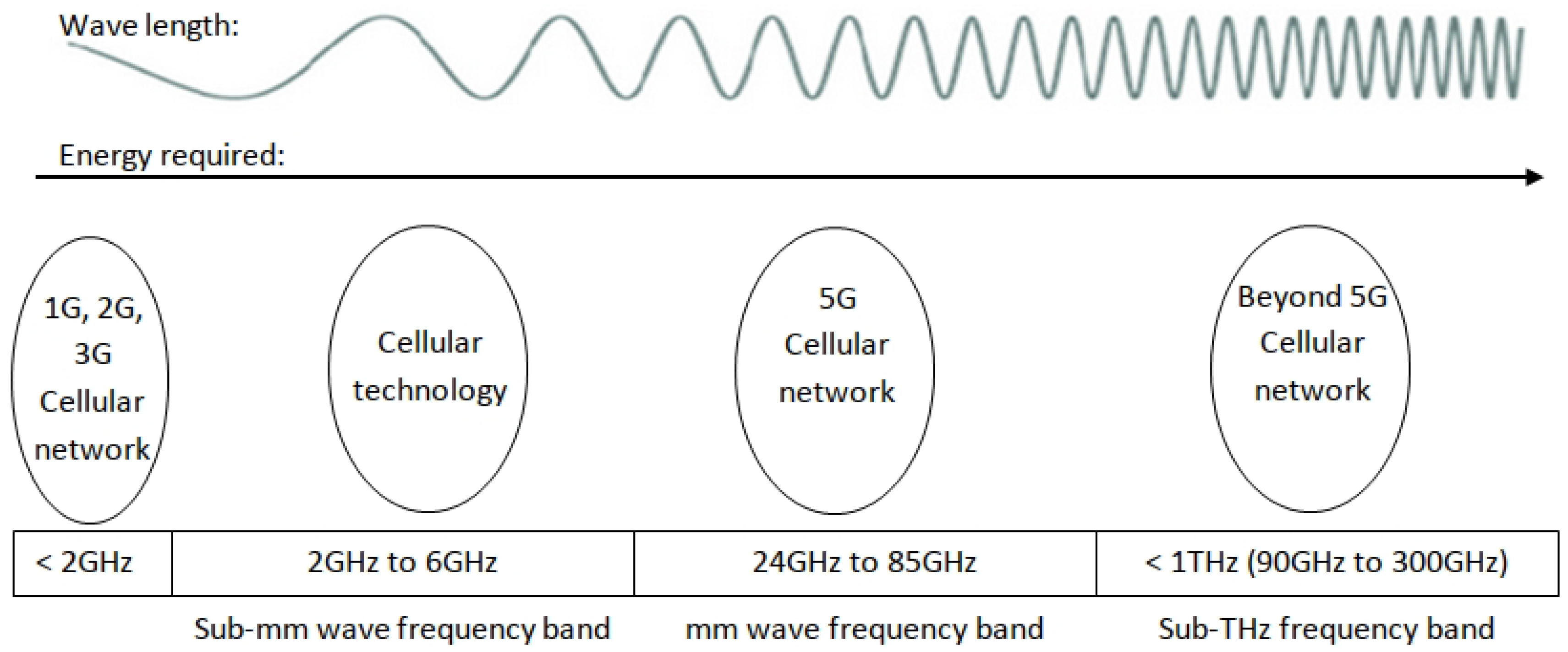
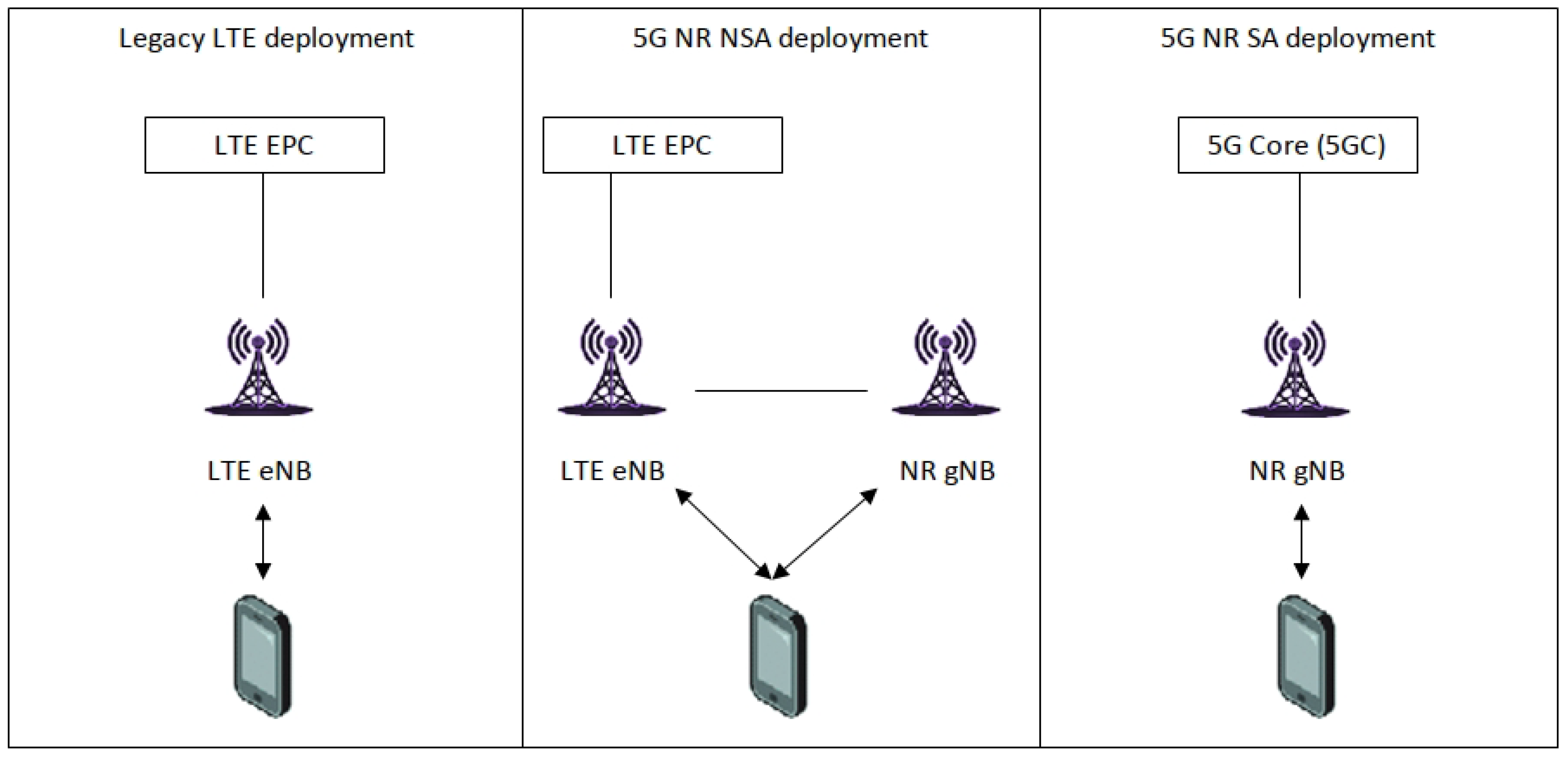
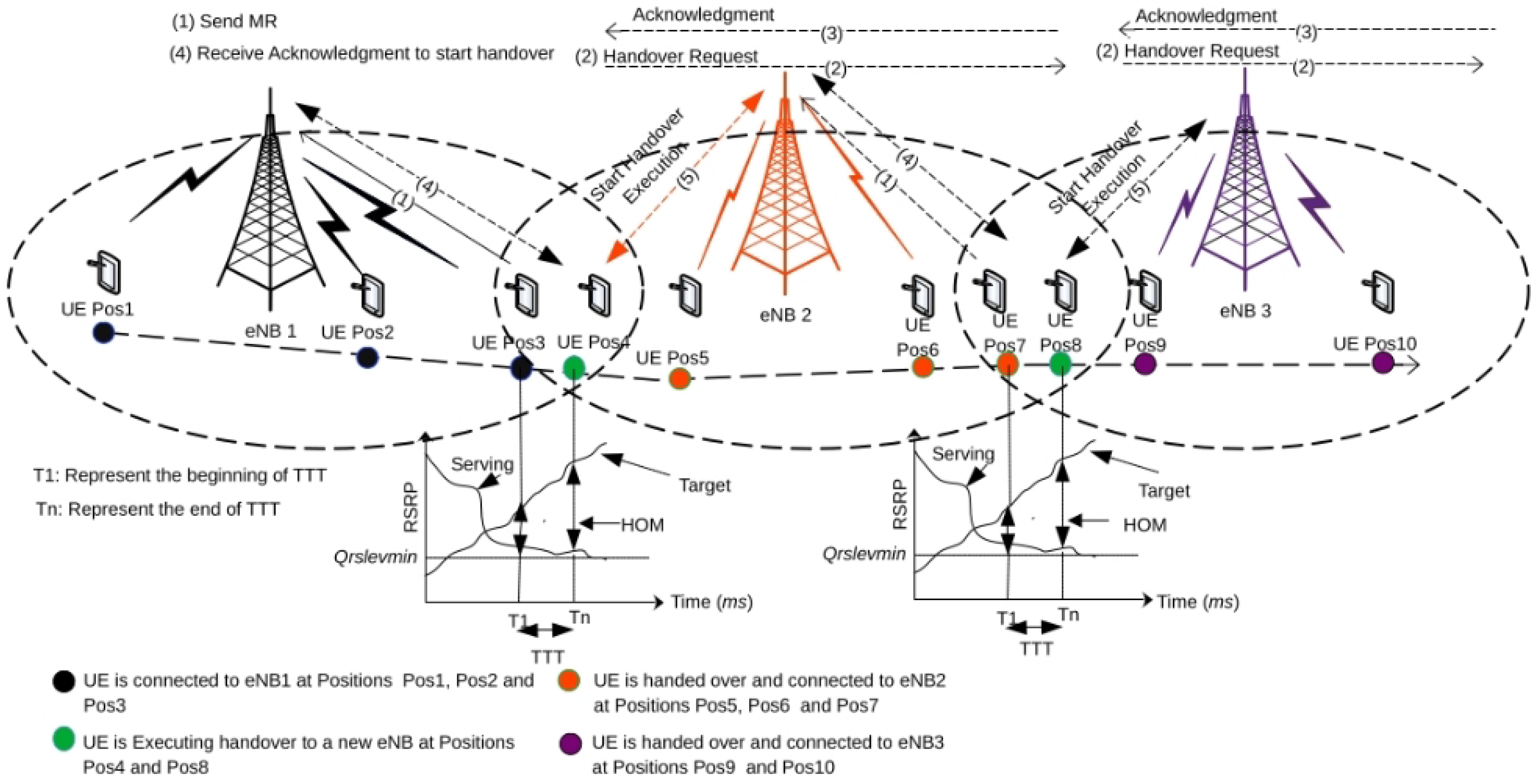
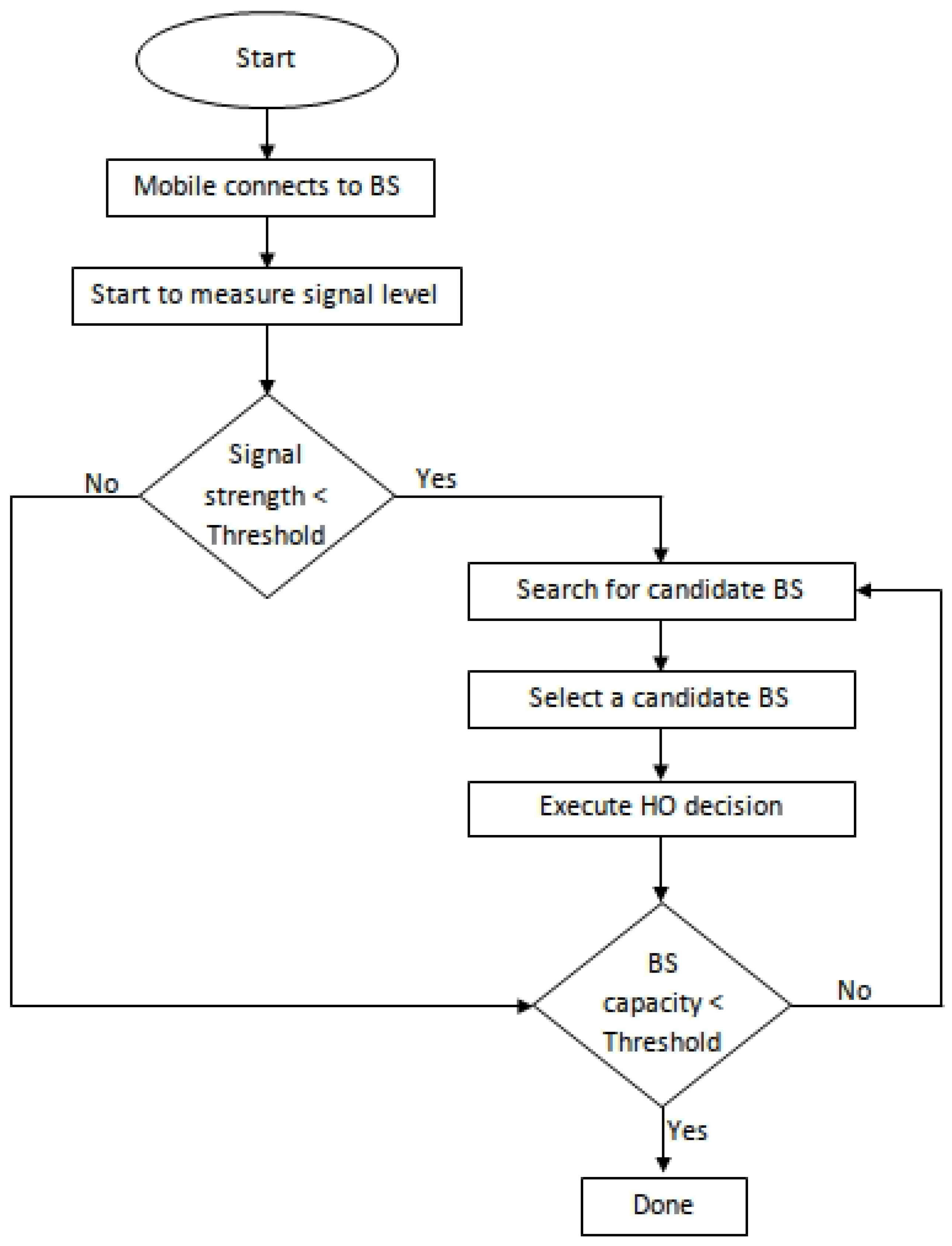
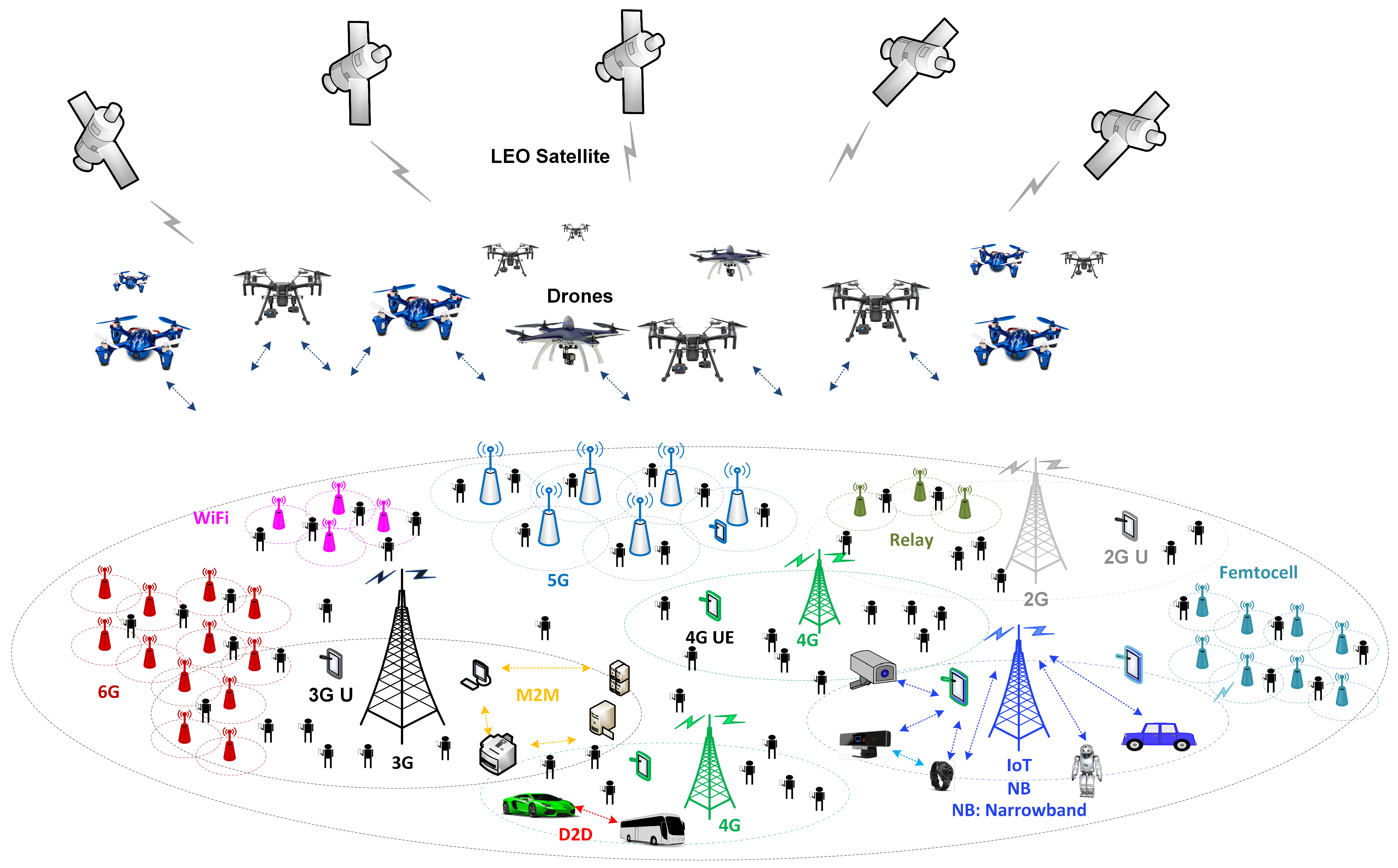
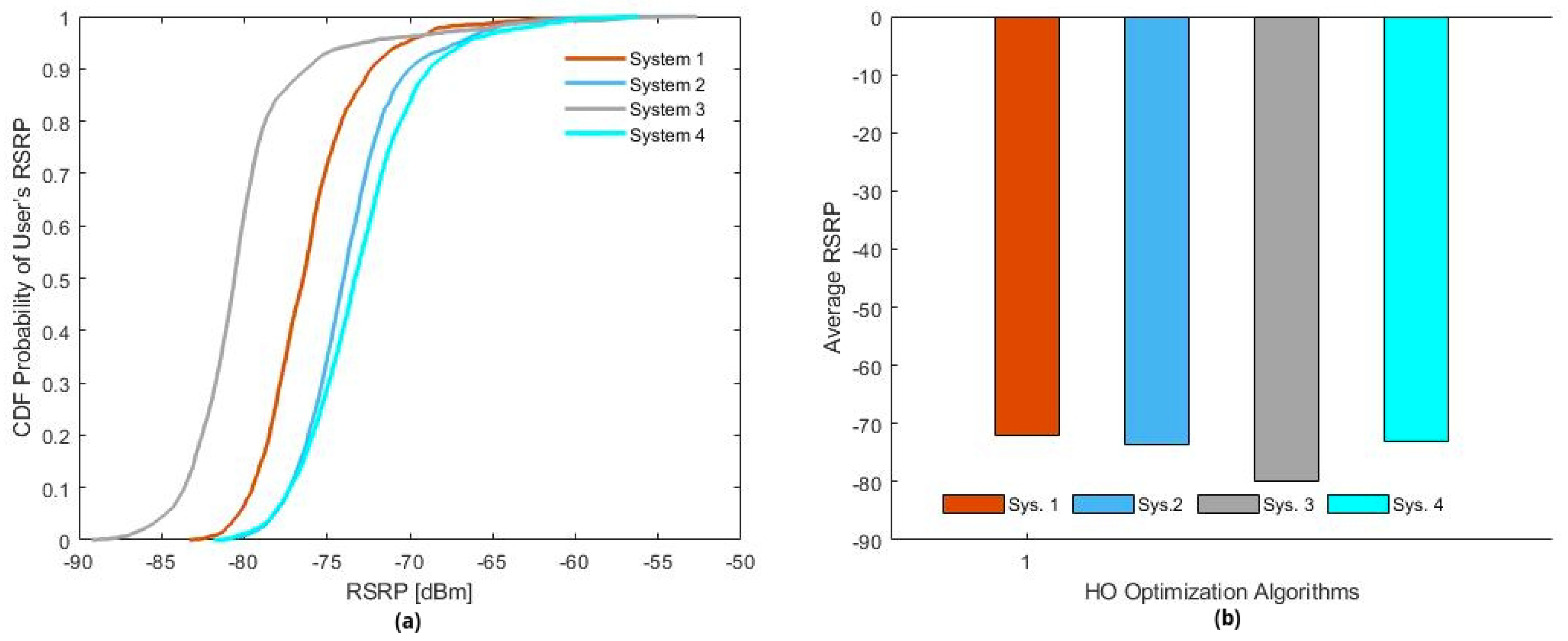
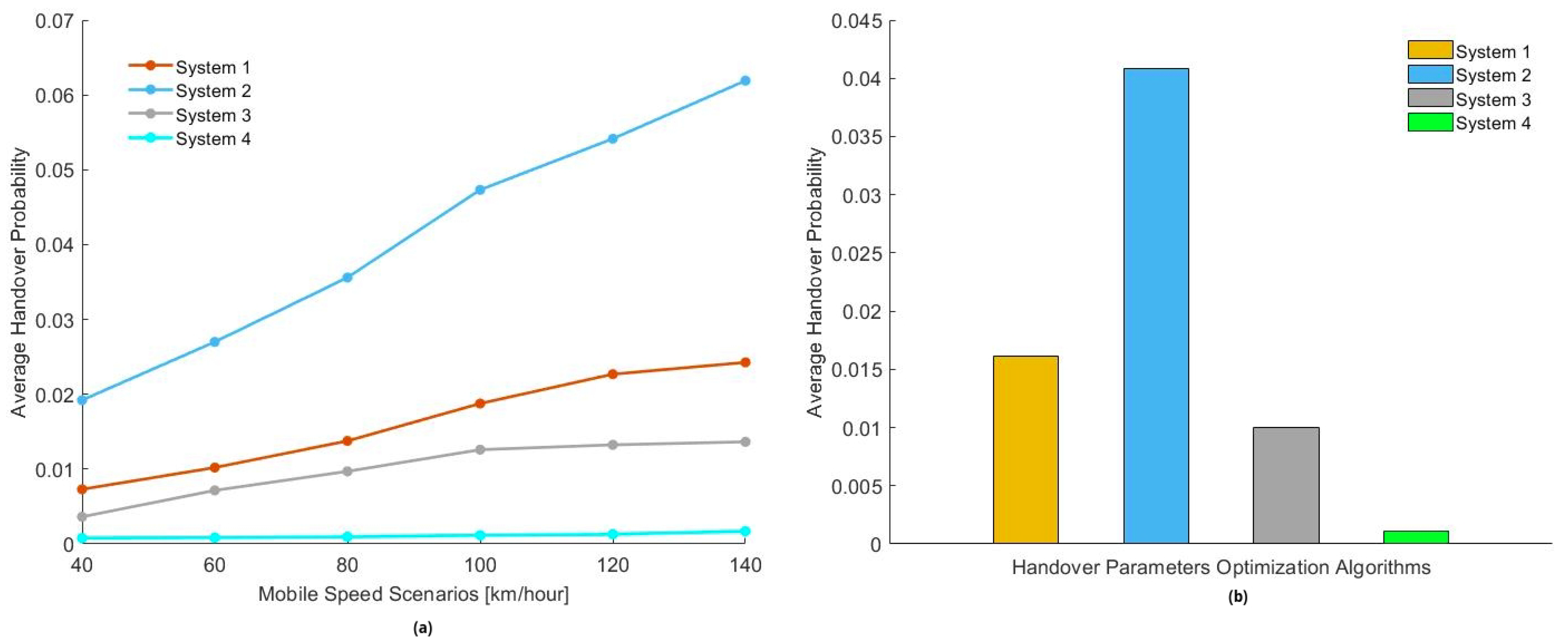
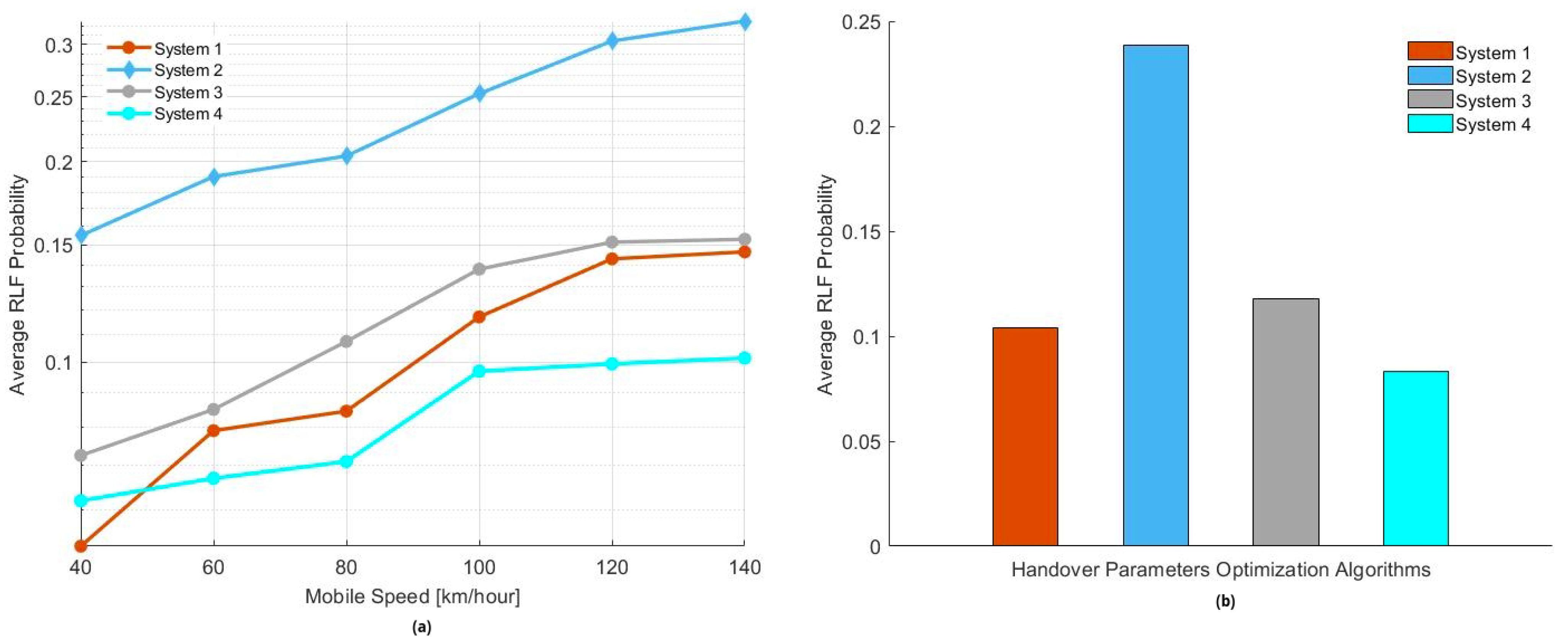
| HODPs | HCPs |
|---|---|
| Signal Strength Thresholds | Signal Strength Thresholds (used for HO initiation) |
| LB Parameters | LB Parameters (control HOs for traffic distribution) |
| QoS Parameters | QoS Parameters (control HOs based on service requirements) |
| Measurement Reporting Configuration | Measurement Reporting Configuration (controls frequency of measurement reporting) |
| Ref | Focus | Methodology | Key Findings |
|---|---|---|---|
| [66] | 5G HO process and mobility impact | Extensive measurements during cross-country drive | Identified challenges in NSA deployments; Prognos HO prediction system improves QoE for 5G applications (e.g., 16K video) |
| [67] | Energy efficiency in femtocell UDNs | Simulation of UL and DL HO mechanisms | New target cell algorithm based on UL-RSRP reduces HO rate and ping-pong rate; improves power consumption and packet loss |
| [68] | HO decision algorithms in femtocell-macrocell setups | Algorithm development and simulation | Novel HO decision algorithm reduces unnecessary handovers and improves energy efficiency by over 85% |
| [69] | Robust HO optimization with fuzzy logic | RHOT-FLC validated across mobility scenarios | Up to 95% reduction in HO probability, failure, ping-pong, latency, and interruption time |
| [70] | Bayesian Optimization for HO thresholds | Multi-objective Bayesian Optimization for indoor factory | Efficiently identifies Pareto-optimal HO thresholds, minimizes early/late HOs |
| [71] | Weighted function and trigger timer for HO ping-pong | Simulation with speed-aware weighted functions | Significant reduction in HO ping-pong probability, outperforming fuzzy logic controllers |
| [72] | Metaheuristic optimization combining KGMO and ALO | Simulation in MATLAB environment | Improved throughput, delay, and HO rates compared to other metaheuristics |
| [73] | Hybrid KGMO-ALO optimization algorithm | MATLAB simulations comparing metaheuristic techniques | Enhancements in throughput and HO efficiency for heterogeneous LTE networks |
| [74] | HO optimization for high-speed trains and drones | Trigger timer and weighted algorithm based on network parameters | Reduced RLF, HO ping-pong, HO probability, and HO interruption time significantly |
| [75] | Fuzzy logic controller for HO decisions in UD-SCN | FLC dynamically adjusting TTT and HOM | Significant improvement in HO rate, failure, RLF, and ping-pong compared to existing methods |
| [76] | Sequence-to-sequence modeling for HO prediction | Predicts HO cells and dwell times using historical trajectory data | Achieved over 90% HO cell estimation accuracy and low mean absolute error for dwell time |
| [77] | Proactive mobility management framework | Advanced Mobility Management and Utilization Framework (A-MMUF) using mobility prediction models | Significant improvements in HO process, mobility load balancing, and energy savings |
| [78] | ML prediction of mobility management tasks | Compared baseline, linear regression, CNN, and LSTM models on HO and TAU message data | LSTM and CNN provided more accurate demand forecasts for LTE and 5G NSA architectures |
| [79] | Early-scheduled HO preparation in 5G-NR | ML-based prediction of earliest HO trigger timing | Reduced channel quality degradation and improved HO robustness and efficiency |
| [80] | DRL for HO minimization in network slicing | Deep reinforcement learning with Proximal Policy Optimization (PPO) | PPO approach significantly reduced HO numbers and improved network efficiency |
| [81] | Network slicing and MEC for HO management | HO mobility management architecture leveraging network slicing for seamless HO between 5G and 4G | Reduced handover disruptions (HODs) and increased average throughput compared to RSS-based and CMaaS HO methods |
| [82] | SDN-based dynamic mobility for high-speed railways | SDN controller with Kalman Filter-based user trajectory prediction for seamless service migration | Migration time reduced by 30%, end-to-end delay reduced by 40%, improved throughput |
| [83] | VHO mechanism integrating IEEE 802.21 with SDN | Centralized SDN control combined with Media Independent Handover for optimized vertical handovers | Significantly fewer unnecessary handovers, improved resource utilization and QoS |
| [84] | Fuzzy logic-based VHO with MIH and PMIPv6 integration | Proposed new VHO algorithm to reduce latency and signaling overhead | Significant reduction in handover delay, packet loss, HO blocking probability, and signaling overhead |
| [85] | Energy-aware mobility management for smart cities and vehicular networks | Review of mobility management protocols for 5G-enabled vehicular networks with focus on sustainable energy usage | Identified design limitations and proposed future research for greener vehicular networks |
| [66] | 5G HO process and mobility impact | Extensive measurements during cross-country drive | Identified challenges in NSA deployments; Prognos HO prediction system improves QoE for 5G applications (e.g., 16K video) |
| [86] | Vehicular Frequency Reuse (VFR) for mmWave 5G CAVs | User-centric channel allocation with Distance-Threshold and Velocity-Threshold metrics; K-Means ML for velocity classification | Over 99% reduction in HO rates; improved link reliability and channel reuse |
| [87] | VFR scheme for high-speed users in mmWave 5G | Similar to [86], with a focus on V2N services and minimal software update integration | Significant reduction in HO rates and control plane signaling; easy integration with existing 5G networks |
| [88] | Energy-efficient mobility management protocol NEMa for vehicular networks | Protocol optimizing network and vehicle sensing for energy efficiency and packet delivery | Outperformed benchmarks in network overhead, latency, and energy consumption |
| [89] | Blockage prediction and HO in mmWave/THz UDNs | Wireless signals combined with computer vision from on-road surveillance to predict blockages and trigger proactive HO | Achieved 40% improvement in connectivity and QoE by predicting and mitigating blockage events |
| [90] | HO scheme for mmWave links using Game Theory and JMLS | Prediction of link deterioration via Game Theory and Jump Markov Linear Systems for optimal link selection | Improved throughput, energy efficiency, reliability, and dwell time, reducing link failures |
| [70] | Multi-objective HO threshold tuning in indoor factory UDN | Bayesian Optimization to balance early and late HOs for service continuity | Efficient tuning of HO parameters to reduce unnecessary handovers |
| [67] | Uplink HO in femtocell UDN | Target cell determination algorithm considering UL-RSRP, bandwidth, and user direction | Reduced HO rates, ping-pong, and energy consumption |
| [68] | HO decision algorithm in macro-femto deployments | Incorporates user speed, RSS, duration of stay, and femtocell policy | Reduced unwanted handovers and improved energy efficiency by 85% |
| [91] | Mobility challenges in 5G HetNets | Analysis of RRC challenges due to dense small cells, HO failures, delays, and ping-pong effects | Highlighted critical challenges for efficient mobility management in dense HetNets |
| [92] | HO in D2D communication | Ping-Pong effect Reduction (PPR) algorithm; Reference Point Group Mobility (RPGM) model; mode selection algorithm | Reduced unnecessary HOs by up to 80%; stable throughput of 12 Mbps; lower power consumption |
| [93] | HO in MIAB networks | Probabilistic modeling of HO scenarios; RACH-less HO procedure; low-latency uplink control plane transmission | Significantly reduced HO delay and overhead; improved QoS in dense mobile environments |
| [94] | Seamless HO in HetNets among macrocells, small cells, femtocells | Self-optimization algorithm balancing MRO and LBO optimization objectives | Reduced HO ping-pong and handover failures; improved network performance and user experience |
| [95] | Predictive HO strategy based on user profiles | Profile-Based Predictive HO Strategy (PBPHS) using mobility and resource utilization data | HO reduction rate improved by 13–26% over existing methods; enhanced QoS |
Disclaimer/Publisher’s Note: The statements, opinions and data contained in all publications are solely those of the individual author(s) and contributor(s) and not of MDPI and/or the editor(s). MDPI and/or the editor(s) disclaim responsibility for any injury to people or property resulting from any ideas, methods, instructions or products referred to in the content. |
© 2025 by the authors. Licensee MDPI, Basel, Switzerland. This article is an open access article distributed under the terms and conditions of the Creative Commons Attribution (CC BY) license (https://creativecommons.org/licenses/by/4.0/).
Share and Cite
Saoud, B.; Shayea, I.; Alnakhli, M.A.; Mohamad, H. Mobility and Handover Management in 5G/6G Networks: Challenges, Innovations, and Sustainable Solutions. Technologies 2025, 13, 352. https://doi.org/10.3390/technologies13080352
Saoud B, Shayea I, Alnakhli MA, Mohamad H. Mobility and Handover Management in 5G/6G Networks: Challenges, Innovations, and Sustainable Solutions. Technologies. 2025; 13(8):352. https://doi.org/10.3390/technologies13080352
Chicago/Turabian StyleSaoud, Bilal, Ibraheem Shayea, Mohammad Ahmed Alnakhli, and Hafizal Mohamad. 2025. "Mobility and Handover Management in 5G/6G Networks: Challenges, Innovations, and Sustainable Solutions" Technologies 13, no. 8: 352. https://doi.org/10.3390/technologies13080352
APA StyleSaoud, B., Shayea, I., Alnakhli, M. A., & Mohamad, H. (2025). Mobility and Handover Management in 5G/6G Networks: Challenges, Innovations, and Sustainable Solutions. Technologies, 13(8), 352. https://doi.org/10.3390/technologies13080352







